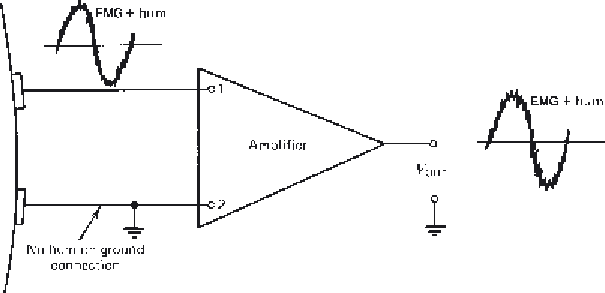Biomedical Engineering Reference
In-Depth Information
Figure 10.9
Single-ended amplifier showing lack of rejection of hum present on
ungrounded active terminal.
radiation comes from domestic power: power cords, fluorescent lighting, and
electric machinery. The resulting interference may be so large as to prevent
recording of the EMG. If we were to use an amplifier with a single-ended
input, we would see the magnitude of this interference. Figure 10.9 depicts
hum interference on the active electrode. It appears as a sinusoidal signal,
and if the muscle is contracting, its EMG is added. However, hum could be
100 mV, and would drown out even the largest EMG signal.
If we replace the single-ended amplifier with a differential amplifier (see
Figure 10.10), we can possibly eliminate most of the hum. Such an amplifier
takes the difference between the signals on the active terminals. As can be
seen, this hum interference appears as an equal amplitude on both active
terminals. Because the body acts as an antenna, all locations pick up the
same hum signal. Because this unwanted signal is common to both active
terminals, it is called a
common-mode signal
. At terminal 1, the net signal is
V
hum
+
emg
1
; at terminal 2 it is
V
hum
+
emg
2
. The amplifier has a gain of
A
.
Therefore, the ideal output signal is:
e
o
=
A(e
1
−
e
2
)
=
A(V
hum
+
emg
1
−
V
hum
−
emg
2
)
=
A(
emg
1
−
emg
2
)
(10.4)
The output
eo
is an amplified version of the difference between the EMGs
on electrodes 1 and 2. No matter how much hum is present at the individual
electrodes, it has been removed by a perfect subtraction within the differential
amplifier. Unfortunately, a perfect subtraction never occurs, and the measure
of how successfully this has been done is given by the common-mode rejec-
tion ratio (CMRR). If CMRR is 1000:1, then all but 1/1000 of the hum will










Search WWH ::

Custom Search